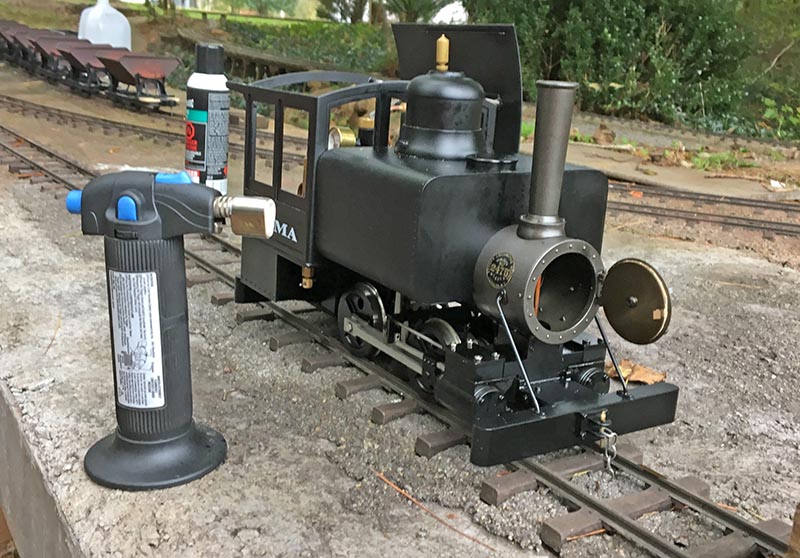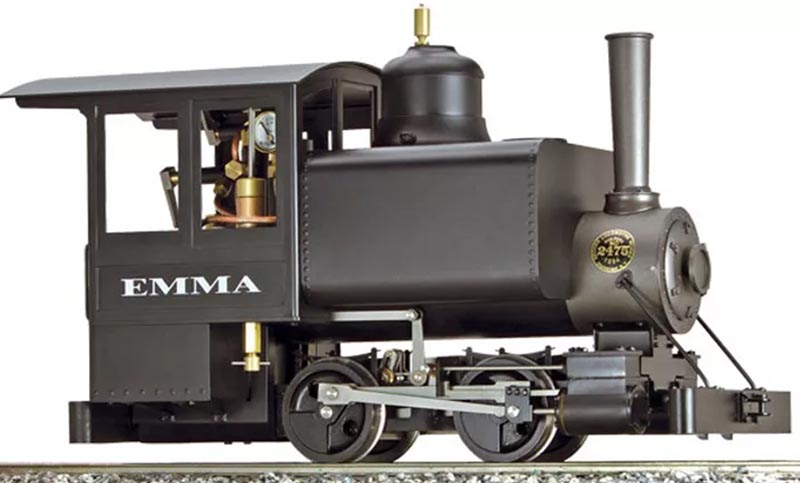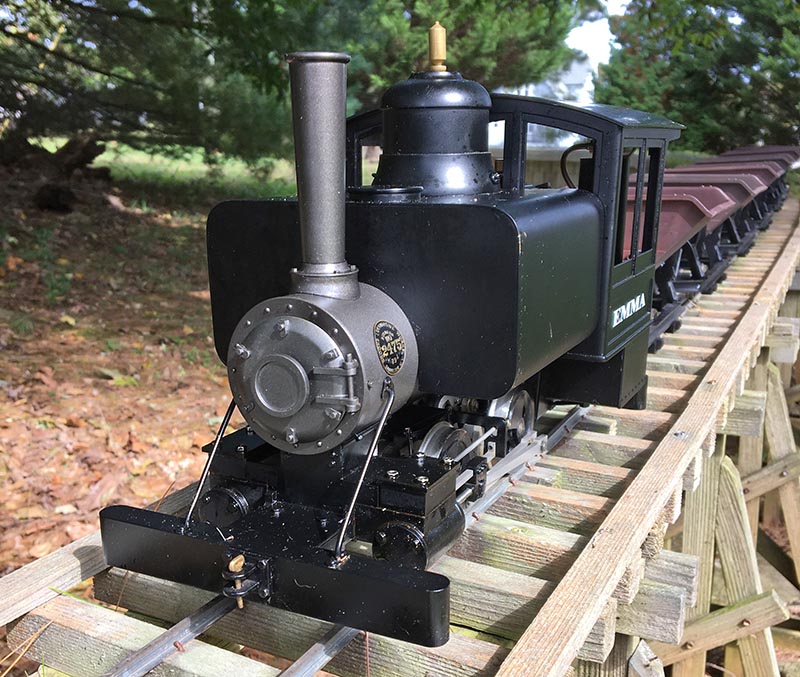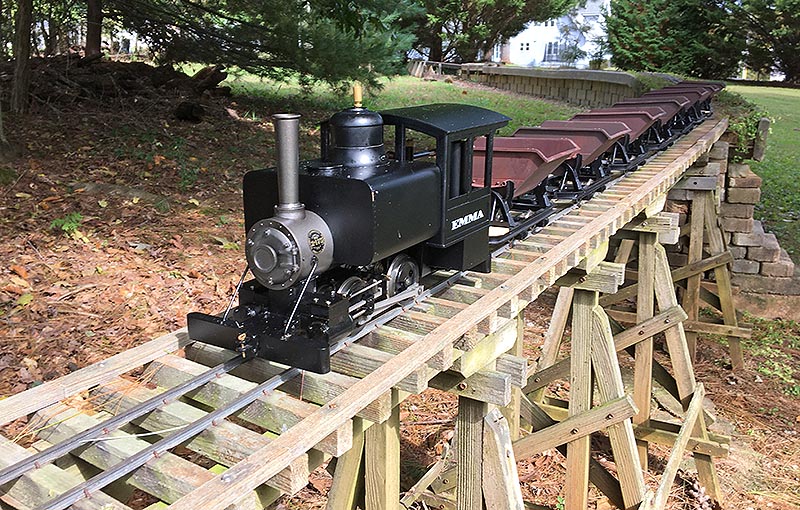By George Riley/photos by the author
The addition of live steam power to a garden railroad not only adds a new dimension to its operation but also a new set of skills to the hobby. You don’t have to be a machinist or even well-heeled to enjoy live steam in their garden. There are several manufacturers of turnkey small steam locomotives. The question that arises among novices is how to best get started in this segment of the hobby?
To come up with what can be considered one of the best starter models of the budding live steam operator we sampled several offerings from three of the leading ready-to-run manufacturers to come up with our recommendation. This was a balancing act of comparing the features, ease of use, reliability and price of each of our samples. Many of us look first at price in making our choices, however, we found that the lower priced models lacked many of the features and controls that are a must to have the full live steam experience. They either were single cylinder oscillators or lacked adequate valve gear for full operation which frequently requires the operator to give the train a push to start the locomotive. Others may be alcohol or tablet fired. Alcohol with its invisible flame can be tricky to properly fire and is potentially the most hazardous, while tablets are sometimes hard to locate, dirty and often of dubious quality.

To this end, the locomotive would need to be butane fired for both ease of use and safety, plus it would need to be able to self-start with the direction control engaged and the throttle gradually opened. Add to this that the model needed to have a decent run time of over fifteen minutes, and one has the base criterion of basic needs. The wish list also included having a sight glass to determine water level, a pressure gauge and lubricator to add steam oil gradually to lubricate the internal moving parts. An added plus being that the locomotive actually resembles a prototype machine rather than a fanciful railroad creation.
Accucraft’s Emma checks off each of the main requirements in addition to being rugged and reliable. The model is based on a two foot gauge 0-4-0T industrial tank locomotive built by the Brooks Locomotive Works of Dunkirk, N.Y., in the later part of the 1800s. Its boxy outline captures the heavy duty appearance of the prototype. At just over a foot long, seven inches tall and five inches wide its mass belies its ability to reliably operate on twenty four inch radius 45mm gauge curves. It will regularly pull seven Bachmann metal chassis dump cars and on occasion, has easily handled over twice that number.

The boiler is of single flue construction commonly featured on miniature steam engines with a butane fired poker burner. This will bring the locomotive up to full steam in around ten minutes depending on ambient external temperatures. The boiler can hold enough water for up to a twenty minute run time with proper firing and throttle settings always keeping in mind the balance between necessary heat versus steam usage. Too high a flame and steam is wasted through the safety valve; too little heat and the locomotive will stall since the cylinders are starved for steam. Obviously, this is all part of the fun of running live steam. Throttle, direction and fuel controls are readily accessible in the locomotives spacious cab. The cab roof is hinged to open for filling the boiler and access to the steam oil lubricator as well as other minor adjustments.
Steam is regulated alternately to each cylinder via D-valves actuated through a modified Stephenson linkage. The timing is set by cams on the front axle which on our sample were set perfectly at the factory and needed no adjustment. Forward and reverse is controlled from the cab by a reversing lever that controls the linkage of the valve gear. Power to the wheels is flawless and smooth with this arrangement.

The Emma is a tried and true performer that even though on the market for a number of years is still available from specialized live steam dealers or manufacturer direct. The pricing fits in with the slightly higher tier of starter locomotives. It gives to user the full steam experience and is frequently used as a base for customization in a number of variations ranging from Forney types to tender locomotives. The novice will not go wrong getting started with this popular model.
There are a few general concepts to keep in mind when one is ready to fire up their first live steam locomotive. The first is that the model once fired up will get hot and if not carefully handled cause burns. The second is that the locomotive is a small pressure vessel and if the safety valve is defective or not installed the boiler can rupture. With the new locomotive out of the box begin by reading the instructions, this step alone will prevent damage to the model or the user.
The first time ‘engineer’ will only need a few items for a successful run. Most of them are available from the local hardware and grocery store. They are:
- A set of wrenches and screw drivers that fit their particular make of model
- Syringes or squeeze bottles for adding fluid to the boiler and steam oil reservoir
- An igniter – the type used for lighting grills comes in handy
- Distilled water – a gallon from the grocery store is usually less than a dollar and will last a complete season
- Steam oil – usually available from the source of the model
- A tin of high quality light machine oil
- Butane – the type used in lighters such as the Ronson brand

Begin by adding water to the boiler making sure to not overfill, leaving room for steam and fill the butane tank with the valve closed. Use only distilled water to avoid boiler deposits. Since butane freezes when it is depressurized i.e. fills the tank let it warm up before trying to run the locomotive. Remember to purchase good quality, clean butane, the type used for lighters and torches is preferred. Since only a relatively small amount will be needed for a day’s operation don’t be tempted to purchase larger quantities of potentially dirtier fuel.
With the butane tank warming, this is a good time to oil all of the moving parts with a high quality light machine oil. This should include but not be limited to all of the wheel bearings and side rod contact points. Also, drain any excess water from and fill the steam oil reservoir. Making sure that there is fresh, clean steam oil available to lubricate the cylinders will greatly extend the life of the machine. Finish by checking all the fittings to make sure they are properly tightened. At this point the new locomotive is ready for its first steam up, so place it on the ready track and light the fire. In a few minutes it’s ready to go.
7/8ths Scale Emma 0-4-0
Item # B77-501 EMMA 0-4- Unlettered, Black with gray smoke box and chimney
B77-502 EMMA (lettered), Black with gray smoke box and chimney
MSRP – $1095.00
Accucraft Trains
33260 Central Ave.
Union City, CA 94587
(510) 324-3399




